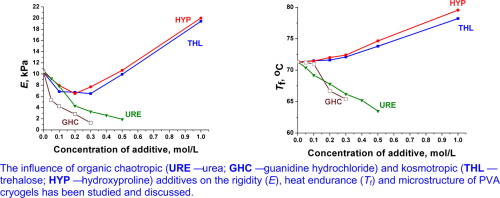当前位置:
X-MOL 学术
›
Eur. Polym. J.
›
论文详情
Our official English website, www.x-mol.net, welcomes your feedback! (Note: you will need to create a separate account there.)
Cryostructuring of polymeric systems. 48. Influence of organic non-ionic and ionic chaotropes or kosmotropes on the cryotropic gel-formation of aqueous poly(vinyl alcohol) solutions, as well as on the properties and microstructure of the resultant cryogels
European Polymer Journal ( IF 6 ) Pub Date : 2018-05-01 , DOI: 10.1016/j.eurpolymj.2018.03.010 Olga Yu Kolosova , Ilya N. Kurochkin , Ilya I. Kurochkin , Vladimir I. Lozinsky
European Polymer Journal ( IF 6 ) Pub Date : 2018-05-01 , DOI: 10.1016/j.eurpolymj.2018.03.010 Olga Yu Kolosova , Ilya N. Kurochkin , Ilya I. Kurochkin , Vladimir I. Lozinsky

|
Abstract Physical (non-covalent) macroporous cryogels of poly(vinyl alcohol) (PVACGs) are formed as a result of the consecutive freezing of concentrated PVA solutions, their incubation in a frozen state and then thawing. If some additional low-molecular-weight solutes are present in the feed system to be gelled cryogenically, such additives can affect more or less the physicochemical properties and the microstructure (porous morphology) of the resultant PVACGs. In this study the influence of the additives of organic non-ionic and ionic chaotropes (urea and guanidine hydrochloride) or kosmotropes (trehalose and hydroxyproline) on the PVA cryotropic gel-formation, as well as on the properties and structural features of the respective PVACGs was explored. It was shown that both the strength and the heat endurance of cryogels formed in the presence of chaotropes progressively decreased with increasing the additive concentration. In turn, in the case of cryogels prepared in the presence of kosmotropes the dependences of the physicomechanical characteristics on the additive concentration were of a bell-like (concave) type, while the heat endurance of the samples grew monotonically. The microstructure of the PVAGCs containing various amounts of the chaotropes and the kosmotropes was studied using the optical microscopy of thin sections followed by the mathematical analysis of the images. The average size of the pore cross-section and the “conditional porosity” of the respective specimens were characterized quantitatively.
中文翻译:

聚合物系统的低温结构化。48. 有机非离子和离子离液剂或 kosmotropes 对聚乙烯醇水溶液的低温凝胶形成的影响,以及对所得冷冻凝胶的性质和微观结构的影响
摘要 聚乙烯醇 (PVACG) 的物理(非共价)大孔冷冻凝胶是将浓缩的 PVA 溶液连续冷冻、在冷冻状态下孵育然后解冻的结果。如果进料系统中存在一些额外的低分子量溶质以进行低温凝胶化,则此类添加剂或多或少会影响所得 PVACG 的物理化学性质和微观结构(多孔形态)。在这项研究中,有机非离子和离子离液剂(尿素和盐酸胍)或亲液剂(海藻糖和羟脯氨酸)的添加剂对 PVA 冷冻凝胶形成的影响,以及对各自 PVACG 的性质和结构特征的影响被探索。结果表明,在离液剂存在下形成的冷冻凝胶的强度和耐热性都随着添加剂浓度的增加而逐渐降低。反过来,在存在 kosmotropes 的情况下制备的冷冻凝胶的情况下,物理机械特性对添加剂浓度的依赖性呈钟形(凹面)型,而样品的耐热性单调增长。使用薄切片的光学显微镜随后对图像进行数学分析来研究含有不同量离液剂和致液剂的 PVAGC 的微观结构。定量表征了各个样品的孔隙横截面的平均尺寸和“条件孔隙率”。反过来,在存在 kosmotropes 的情况下制备的冷冻凝胶的情况下,物理机械特性对添加剂浓度的依赖性呈钟形(凹面)型,而样品的耐热性单调增长。使用薄切片的光学显微镜随后对图像进行数学分析来研究含有不同量离液剂和致液剂的 PVAGC 的微观结构。定量表征了各个样品的孔隙横截面的平均尺寸和“条件孔隙率”。反过来,在存在 kosmotropes 的情况下制备的冷冻凝胶的情况下,物理机械特性对添加剂浓度的依赖性呈钟形(凹面)型,而样品的耐热性单调增长。使用薄切片的光学显微镜随后对图像进行数学分析来研究含有不同量离液剂和致液剂的 PVAGC 的微观结构。定量表征了各个样品的孔隙横截面的平均尺寸和“条件孔隙率”。使用薄切片的光学显微镜随后对图像进行数学分析来研究含有不同量离液剂和致液剂的 PVAGC 的微观结构。定量表征了各个样品的孔隙横截面的平均尺寸和“条件孔隙率”。使用薄切片的光学显微镜随后对图像进行数学分析来研究含有不同量离液剂和致液剂的 PVAGC 的微观结构。定量表征了各个样品的孔隙横截面的平均尺寸和“条件孔隙率”。
更新日期:2018-05-01
中文翻译:

聚合物系统的低温结构化。48. 有机非离子和离子离液剂或 kosmotropes 对聚乙烯醇水溶液的低温凝胶形成的影响,以及对所得冷冻凝胶的性质和微观结构的影响
摘要 聚乙烯醇 (PVACG) 的物理(非共价)大孔冷冻凝胶是将浓缩的 PVA 溶液连续冷冻、在冷冻状态下孵育然后解冻的结果。如果进料系统中存在一些额外的低分子量溶质以进行低温凝胶化,则此类添加剂或多或少会影响所得 PVACG 的物理化学性质和微观结构(多孔形态)。在这项研究中,有机非离子和离子离液剂(尿素和盐酸胍)或亲液剂(海藻糖和羟脯氨酸)的添加剂对 PVA 冷冻凝胶形成的影响,以及对各自 PVACG 的性质和结构特征的影响被探索。结果表明,在离液剂存在下形成的冷冻凝胶的强度和耐热性都随着添加剂浓度的增加而逐渐降低。反过来,在存在 kosmotropes 的情况下制备的冷冻凝胶的情况下,物理机械特性对添加剂浓度的依赖性呈钟形(凹面)型,而样品的耐热性单调增长。使用薄切片的光学显微镜随后对图像进行数学分析来研究含有不同量离液剂和致液剂的 PVAGC 的微观结构。定量表征了各个样品的孔隙横截面的平均尺寸和“条件孔隙率”。反过来,在存在 kosmotropes 的情况下制备的冷冻凝胶的情况下,物理机械特性对添加剂浓度的依赖性呈钟形(凹面)型,而样品的耐热性单调增长。使用薄切片的光学显微镜随后对图像进行数学分析来研究含有不同量离液剂和致液剂的 PVAGC 的微观结构。定量表征了各个样品的孔隙横截面的平均尺寸和“条件孔隙率”。反过来,在存在 kosmotropes 的情况下制备的冷冻凝胶的情况下,物理机械特性对添加剂浓度的依赖性呈钟形(凹面)型,而样品的耐热性单调增长。使用薄切片的光学显微镜随后对图像进行数学分析来研究含有不同量离液剂和致液剂的 PVAGC 的微观结构。定量表征了各个样品的孔隙横截面的平均尺寸和“条件孔隙率”。使用薄切片的光学显微镜随后对图像进行数学分析来研究含有不同量离液剂和致液剂的 PVAGC 的微观结构。定量表征了各个样品的孔隙横截面的平均尺寸和“条件孔隙率”。使用薄切片的光学显微镜随后对图像进行数学分析来研究含有不同量离液剂和致液剂的 PVAGC 的微观结构。定量表征了各个样品的孔隙横截面的平均尺寸和“条件孔隙率”。



























 京公网安备 11010802027423号
京公网安备 11010802027423号